.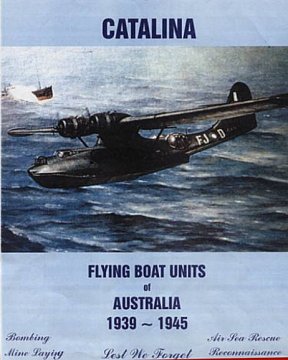
A SALUTE TO OUR BROTHERS DOWN UNDER
We thank Member, Howard Elliott, Winnipeg, Manitoba, for
the following.
Darwin Australia November 1944.
Catalina RAAF A24-87. Crew:
P/O Keith Houston
Captain
W/O Arthur Brown
2nd. Pilot
W/O Terry O’Brian
Navigator
F/S J.Keith Bower
Wireless Op. Air Gunner
F/S J. Alex Sim
Wireless Op. Air Gunner
F/S H. (Tex) Morton
1st. Flt. Engineer
Sgt. George Boden
2nd. Flt. Engineer
Sgt. Jock Clough
Armourer/Gunner
Sgt. Jack Willis
Armourer/Fitter
A Mine Laying Mission In a Catalina from the First
Engineer’s Position
By Tex Morton.
Catalina aircraft are quite unique to any other aircraft
as the fuselage becomes the hull, with a keel, chine, bollards etc. and
all gear is in naval terms.
As the aircraft has to operate, in most cases, on its
own away from the home base, the crew are made up of the following: 2 pilots,
1 navigator, (doubling as bomb aimer), two wireless operator air gunners.
The remaining four crew members are remustered qualified ground staff;
2 engine fitters, 1 airframe fitter, and 1 armourer. All RAAF aircraft
must have a daily inspection by qualified persons before they are allowed
to fly, and form EE77 must be signed, names of all persons on board have
to be entered on the form.
We were airborne at dusk from Darwin heading North and
skirting around the Jap held Ambon Island, up past the Western tip of Dutch
New Guinea, over the equator about 60 miles, and land at the Island of
Marati. We were to operate with the USA Navy, their sea plane tender “The
US Tangiar” was to supply our planes with all their needs.
After mooring up amongst a line of US Navy Catalinas,
which, to our crew seemed a bit too close to shore, we were informed by
the boast crew that two of their planes were cut below the water line during
the night. To avoid sinking, these planes were towed over to, and hoisted
aboard the “Tangiar for urgent hull repairs. That was news we could have
done without. It was decided that all RAAF flying boats would have an anchor
watch every night they were moored up.
The crew had to form the watch, 2 hours on and 2 hours
off, guns loaded, one in the breech, feed belts connected ready to go if
needed. The Skipper came aboard about 0830 hrs. and informed the crew that
we had a long and hard trip tonight, requested the fuel tanks filled to
maximum and to give the engines a thorough check. To check the engines
we had three work
platforms, two clipped onto the side of the engine with
the third slung underneath. The main source of oil leaks are the 28 rocker
box covers, and return oil lines to the oil tank.
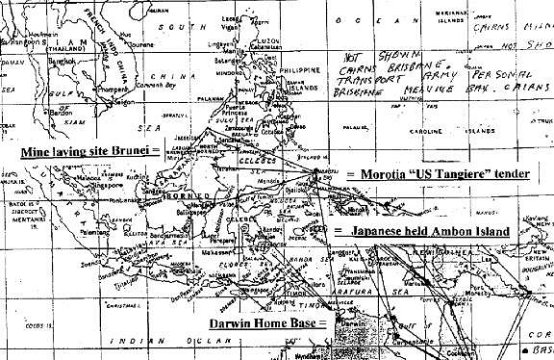
Flight plan – Darwin, Skirt enemy held Ambon Island,
Morotia (to refuel), Brunei (drop site) and
return.
The fuel barge arrived and we loaded the maximum
amount of fuel, 1460 Imperial gallons. Tank caps were locked and (good
old RAAF practice) secured with locking wire. Next to arrive were the U.S.
Navy with 2 mines (about 1 Imperial ton each) made up of 1760 lbs of high
explosive in high tensile steel case, plus dry battery, firing mechanism
and parachute.
The Skipper and rest of the crew arrived about 1430 hrs.
with the news we were to mine the oil producing port of Bunri down the
West coast of Borneo.
After engine start up, the aircraft was prepared for take
off. Airscrew pitch control fine, mixture controls to full rich, fuel cross
feed on, hand fuel pumps locked off, sea droughs stowed, gun blisters closed.
For an overloaded aircraft to take off in the hottest part of the day will
mean a long run. As soon as the cylinder head temperature reached 150,
oil temperature 40, I called the Skipper, “all clear for take off.”
By now we were out in the middle of the bay, turned into
wind (with a small chop on the water), increased engine RPM to 2700 with
manifold pressure at 48” and we were away. One would need good imagination
to think that this overloaded Cat, sitting low in the water would ever
fly. Still, the bow rose up, spray covered both windows, we gathered speed,
up onto the hull step, lifted off, touched down again, then started to
climb.
Maximum take off engine power can only be used for two
minutes, so RPM was reduced to 2300, manifold pressure to 35” and we climbed
to 7000 feet. The Skipper has the engine throttle and airscrew pitch control
(RPM) All engine controls are left to the Engineer, which include manual
mixture control, fuel flow meters, fuel gages, temperature gauges etc.
We settled down to cruising RPM of 1950, manifold pressure
30”. The Starboard engine cylinder head temperature came below the maximum
cruising, but the port engine was still running too hot. To cool an engine
in flight you have to enrich the mixture, so a quick decision to
increase the fuel flow by one imperial gallon per hour to port engine had
the desired effect.
After three hours of flight a crew change takes place.
Fitter 2A and Armourer start to prepare a meal, 2nd. Engineer takes my
place. Myself and 1st. Wireless Operator take up positions in the gun blisters.
A couple of more crew changes and we are getting close to the Borneo Coast.
Skipper requests all crew get into operational gear, which means boots,
long slacks, sleeve shirts, webbing belt, which carries water bottle, emergency
rations, medical kit, ammo pouch, and revolver. Next is an inflatable life
jacket, and over the lot, your parachute harness, as the pack is on the
bulkhead near your feet.
The Engineers position is in a small section which connects
the hull to the underside of the mainplane, with a good view either
side. For the last hour before reaching the target we descend to 50 feet
or less to keep under the radar, which means the aircraft must be hand
flown. For a successful mine drop, operations room, from a detailed map
work out the deepest water along the shipping channel, select datum point
(starting point), compass heading, air speed, height, and length of run
to the first mine drop from datum point. Tonight it will be 90 seconds
to the first drop then 32 seconds to the second drop.
Crew duties on a mine run: Skipper flies the plane, 2nd.
Pilot maintains air speed, Navigator in the bow position with stopwatch
in one hand and release button in the other, does the count down from datum.
As the mines are hooked onto racks under the wing each side of my position,
I have to report each mine gone, as they have been known to hang up on
one hook.
We are now flying down the West Coast of Borneo. Skipper
sets the Cat at mine laying air speed, and from his position can see the
exhaust stubs, and we are showing a red flame. A call on the intercom to
lean the fuel mixture down to produce a blue flame. This is done but we
lose a bit of our air speed. An increase in RPM brings the speed back up.
We re now flying up the Western side of Bruni Bay
to pick up our datum point. I look out the port window and count 13 “Zekes”(Zero
fighters on floats) on the water. We turn at the top of the bay on to our
mining run, cross our Datum point, and the counting starts, 90 seconds
to the first drop. Again I look out the port window and 5 of those “Zekes”
are circling around warming up for take off. We are flying straight and
level. I glance at the second hand of the clock on the panel in front of
me.. I would have bet any money that second hand was stuck to the inside
of the glass, … but no, the count is now 60—70—80—90—I report “Port
mine gone.” Then 10—20—32 “Starboard mine gone.” The tail rises, the wing
is relieved of its 2 ton load and up goes the airspeed. None to soon, I
know the Skipper has seen the “Zekes”! To our relief there is a storm developing
on our starboard side, something you would normally stay out of, but those
“Zekes” can’t be far behind and the cloud cover is very welcome.
We round the top of Borneo and head East and the crew
have already commenced the preparation of a meal and the Billy ready to
boil. We are just breaking out of the storm when we drop into an air pocket.
What should have been a meal is now upside down in the bilge! I now recheck
my fuel measurements to give the skipper an accurate report of the remaining
fuel.
The Navigator drops a flame float onto the water below
to get a wind drift from about the 5 o’clock position. Every hour, as the
load decreases, we are lowering the RPM to give the best airspeed and to
save fuel.
It is now about 0900 hours. I look out the port window
and in the eleven o’clock position is the seaplane tender. The Skipper
calls for a final fuel report, which is 15 Imperial gallons. “Don’t circle
or we will be pushing it home!” He request the fuel feed cross flow left
off. If we are going to run out of fuel, he prefers to lose one engine
at a time.
The Skipper calls up for, and is given, permission to
land. We then taxi to a mooring buoy with both engines still running. The
stop engine signal lights up on the panel … but one thing yet remains ..
to sign off the engine log, 18.35 hrs. flying. The crew are up on the wing
when we opened the tank caps to see what fuel was left. It was a strip
about 6” wide from the back edge of the tank.
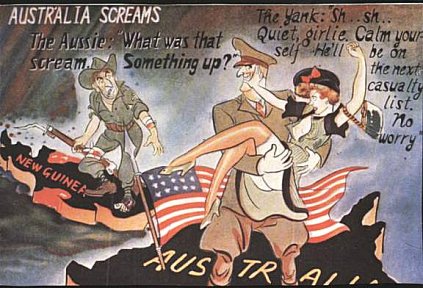
Japanese propaganda leaflet – 1942
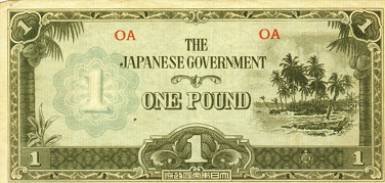
A One Pound note printed by the Japanese to be used
if they occupied Australia.

Japanese currency notes used during the
Philippines occupation 1942 – 1945.
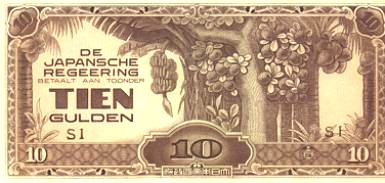
Japanese Currency notes used during the
Netherlands East Indies occupation 1942 – 1945.
Original notes provided by Jack Haywood
Don Macfie
After reading “P/O Prune Catches a Code” I remembered
my old “WAGs Bag”, which has been hanging on the wall for 60 years, almost.
I looked in there and by golly amongst log books and other goodies, there
was Air Publications 3036 1st. publication 1943. “For Use in the Air Only.”
Q Codes amended.
QBA – what is the visibility at ?
QAH – what is your height ?
QFE – can you give me the present barometric pressure
at airport surfase?
QTH – what is your position in latitude & longitude?
QFO – may I land direct?
QFR – your undercarriage is damaged.
QGH – you may land using procedure of descent through
cloud.
QGX – may I land using ZZ procedure?
QDR – what is my magnetic bearing in relation to you?
QFT - between what heights has the danger
of ice formation been
signalled?
QTR - the exact time is……….
QAA - beware of collision, other aircraft
flying in vicinity.
QAL - I am going to land at……….. .
QDM - the magnetic course to steer with zero wind
to reach me is………. .
There was no mention of QVG in the publication.
Ed. Maybe, as the line reads “He stood and shouted QVG”,
Prune, as usual, was confused and there isn’t such a code.
Interested parties can check out the May Page which displays
the TEE EMM poem "P/O PRUNE CATCHES A CODE" and apply the code.
Example: Verse One,
P/O Prune went into town;
Of beer he had his fill;
So when they asked him “QBA?”
(what is the visibility?)
He answered sadly “NIL”,
Erik Nielsen forwarded
the following
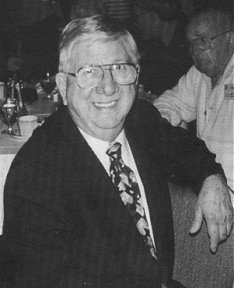
Erik at Ex-Air Gunner’s Reunion Sept. 2000
Q code
From Wikipedia, the free encyclopedia.
The Q code is a set of three-letter code signals
to be used in radiotelegraphy and amateur radio communications. It was
developed and instituted in 1912 as a way to facilitate communication between
maritime radio operators of different nationalities. For this reason, callsigns
never begin with a Q.
Used in their formal "question/answer" sense, their meaning
varies depending on whether they are sent as a question or an answer. For
example, the message "QRP?" means "Shall I decrease transmitter power?",
and a reply of "QRP" means "Yes, decrease your transmitter power". This
structured use of Q codes is fairly rare and now mainly limited to amateur
radio and military CW traffic networks.
Many militaries and other organizations that use Morse
code have their own code they use besides the Q code, such as the Z code
that is in use in most European and NATO countries. The Z code contains
many commands and questions that are needed in military radio transmissions,
that were not included in the Q codes, such as ZBW 2 (change to backup
frequency nr. 2) or ZNB abc (my checksum is abc, what is yours).
For instance, in most military Morse code transmissions,
any freeform text is strictly forbidden and all communications must be
accomplished by the use of three-letter abbreviations, the Q and Z code.
Q Codes used commonly used in amateur practice
| Code |
Meaning |
Sample use |
| QRL |
Is this frequency busy |
Used almost exclusively with Morse code |
| QRM |
Man-made interference |
There's another QSO up 2 kHz that's causing you a lot
of QRM |
| QRN |
Static crashes |
The band is noisy today; I'm hearing a lot of QRN |
| QRO |
Increase transmitting power |
I need to QRO when propagation is poor. |
| QRP |
Low(er your) transmitting power |
I'm using a QRP transmitter here, running only 3 watts |
| QRS |
Send your Morse code more slowly |
Please QRS, I'm new to Morse code |
| QRT |
Stop sending |
I've enjoyed talking to you, but I have to QRT for dinner
now |
| QRV |
Ready to receive |
Will you be QRV in the upcoming contest? |
| QRX |
Hang on a minute, I'll be right back |
Please QRX one |
| QRZ |
Who is calling me? |
QRZ? I hear someone calling, but you're very weak |
| QSB |
Fading of signal |
I'm hearing a lot of QSB on your signal |
| QSL |
Acknowledge receipt |
I QSL your last transmission |
| QSO |
A conversation with another ham |
Thanks very much for the QSO |
| QSY |
Change frequency |
Let's QSY up 5 kilohertz |
| QTH |
Location |
My QTH is South Park, Colorado |
| QTR |
Exact time |
QTR is 2000 Z |
(Members will remember Erik as the guest speaker
at our final reunion September 2000. Erik did his first tour on 101 RAF
Sqdn. It was a Special Duties Sqdn conducting "Airborne Cigar" operations
while carrying out the same duties as other A/C in the Bomber Stream. There
were a good number of Canadian Members of the RCAF on 101. Post war Erik
graduated from Dalhousie Law School and applied to enlist in the
Judge Advocate General’s Branch of the RCAF. He was not accepted due to
a bureaucratic technicality.
Erik practiced law in the Yukon, was elected Member
of Parliament, became Minister of National Defence, and Deputy Prime Minister.
From rejection to HEAD MAN. Now that is class!
We could sure use you again Eric, not in the Lanc,
but in The House!)
Bob Henderson
Your “Short Bursts” Web Site continues to be a major source
of information for a massive cross section of people around the world.
The MAY 05 issue included a request for “Short Snorter
Rolls”, which reminded me of an item in the Regina Sk., “Homefront Archives
& Museum Collection.”
On checking I realized that an item on display was exactly
what you were talking about – this being a series of five different samples
of paper currency, with the first and second samples in a row (from left
to right) having signatures on it. The first sample is dated 5/18/44.

5 Kronur - Iceland
10 Shillings – England
Written on the 5 Kronur Note: William J. Gleason
5/18/44 “SHORT SNORTER”
this is followed by signatures, which were legible, of
his crew:
George E. Putching
Ferdinhand G. Rexin
Grayson G. Monnisset
John W. Frazer
Victor G. Aubery JR.
Some first and last names cannot be deciphered
The 10 Shilling note carries the signature: Philip F.
Smith.

10 Francs – Belgium
5 Reichsmark – Nazi Germany
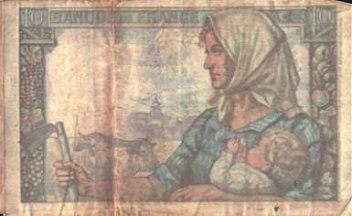
10 Francs - France
They had been collected by William J. Gleason of Tuscon
Arizona, who spent time as a guest of the Germans at Stalag Luft 1 for
Allied Airmen/ He was released in May 1945.
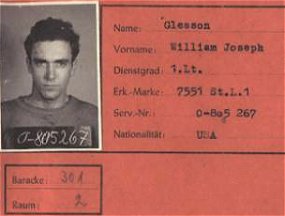
William J. Gleason PoW Identification
Card from German Control Office
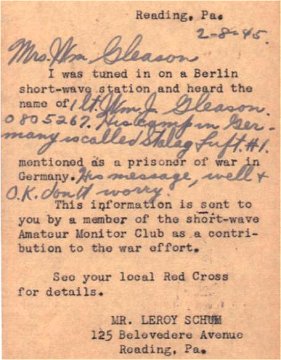
Post Card to family of William J. Gleason from Mr.
Leroy Scum,
Short Wave Amateur Monitor Club, Reading, Pa. Advising
that
Their son was a PoW.
Ted Hackett
Sid Beaudoin, who was Ted Hackett’s boss at Cold Lake
post war, sent Ted the following letter and pictures:
“Some of you may miss the significance of 8 May 2005.
This coming May 8th is the 60th anniversary of VE (Victory in Europe) Day,
the day on which the war against Hitler's Germany came to an end. Admittedly
the Allied Armies and Navies played a significant role in defeating the
German Fifth Reich, Hitler's 'Thousand Year Reich', but my interest is
primarily in the Air Force. I would be the first to admit that the Air
Forces could not have done it by themselves. I probably wouldn't have put
this together except that my good friend Ted sent me some interesting pictures
taken during wartime and I thought that this might be a good way to use
them. There is no sequence to this presentation, nor does one photo necessarily
have a link to the next. They simply commemorate a very difficult job well
done by a large number of brave young men."
I thought that perhaps I would use the first picture to
introduce you to Ted. Please bear in mind that this photo was taken some
60 years ago and you might not recognize Ted if you bumped into him on
the street. Time has wrought changes in all of us.
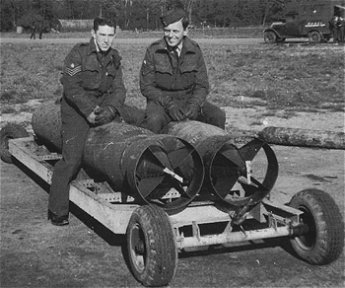
Ted Hackett on left. (Ted can’t remember what he
Is holding in his right hand. Any ideas?
Ted adds:
The other chap is Gordie Heslop, he was our mid-upper.
We met at Manning Depot and when we got to OTU we decided to stay as a
pair. He went back to work at Bailey Meter Co. in Montreal and rose
up through the ranks as it were. He died of cancer a few years ago.
We corresponded over the years and his passing was a sad moment.
We had a lot of fun and I think of him often.
Some other photos Sid Beaudoin sent to Ted:
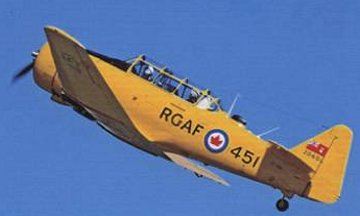
The Work Horse. Many of our Airmen can
say
they graduated from Harvard!
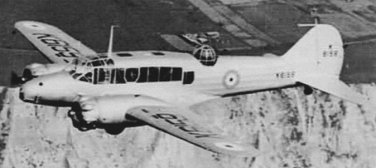
Another Work Horse in CATP. The Avro Anson
Used for training pilots and Navigators.
Then came the War Horses
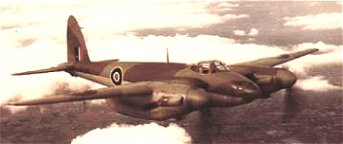
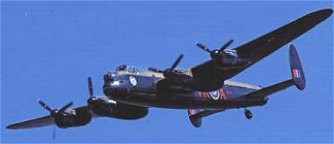
Mosquito - The Canadian plywood jewel of 409 Squadron
,
and the Lancaster
WHERE WERE YOU ON VE-DAY?
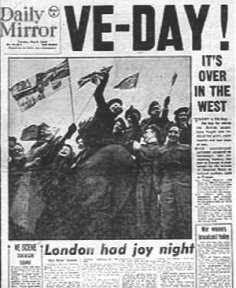 We would like to hear your recollections of VE-DAY. Your
Editor had to fly that day. It seemed that some of the German Submarine
Captains did not get the ceasefire message. War does not come to a complete
stop at the scratch of a pen. Our First Engineer, F/O Benny Hunt, was killed
in an unfortunate accident returning from a patrol on May 13, 1945, five
days after VE-Day. Benny was the last casualty on 422 Squadron.
We would like to hear your recollections of VE-DAY. Your
Editor had to fly that day. It seemed that some of the German Submarine
Captains did not get the ceasefire message. War does not come to a complete
stop at the scratch of a pen. Our First Engineer, F/O Benny Hunt, was killed
in an unfortunate accident returning from a patrol on May 13, 1945, five
days after VE-Day. Benny was the last casualty on 422 Squadron.
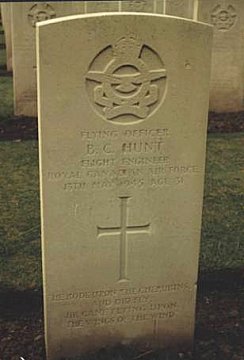
Blacon War Graves Commission Cemetery, Chester, UK.
RCAF C/47486 B. C. Hunt, of Alberta. Wife - Beatrice
Parents William and Lillian Hunt
Grave No. 887, Section ‘A’
LAST POST
CLIFFORD ALVIN SHIRLEY, DFC, DFM, Weyburn, SK.
Cliff was not an Air Gunner but served on 50 Squadron RAF as a Navigator
and Bomb Aimer. Pre war Cliff was a school teacher in South East Saskatchewan,
and when he joined the RCAF in 1940, he was channelled into Navigational
training. The CATP had a propensity to make all teacher enlistees Navigators.
(My Navigator was a teacher). Cliff did his first tour as a Navigator,
his second tour as a Bomb Aimer, and along with is Pilot, Harold Southgate,
was awarded the DFM and DFC. Cliff had great respect for his RAF crew.
Post war Cliff went back to teaching and farming in the
Arcola, SK. Area. As a high school Principal he was liked and respected
by students and staff. I’m taking the liberty of printing this obituary
as Cliff and his wife, Marjorie, were our neighbours at Kenosee Lake, SK.,
for many years.
Those of you who have the book, COMMEMORATIVE ISSUE 1983-93
Selections from SHORT BURSTS, can see one of Cliff’s articles entitled
TV WAR DRAMA DISTORTED TRUTH – page 166. The article, published in the
Winnipeg Free Press, was Cliff’s reaction to the film, The Valour and the
Horror.
ROGER JEAN LERMINIAUX, Indian Head Sask. Passed
away May 15, 2005. Rodger enlisted in the RCAF in 1941, and served overseas
with 425 (Alouette) Squadron as a Tail Gunner from 1943 to 1945. Post war
Roger farmed south of Indian Head.
PHILIP ALFRED DUBOIS
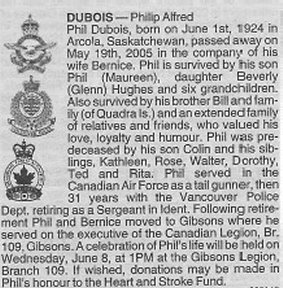
The following Obituaries received from Doug Penny:
BRANCH, HOWARD J. MBR #229 PICTURE BUTTE, AB:
Passed away April 4th, 2005. (No obituary, but Howard's wife phoned
Doug to advise. Howard's brother, Alec, was the Navigator on Doug's
crew). Howard enlisted in Calgary during September 1942. Following
Manning Depot in Edmonton and 6 weeks of Guard Duty at Penhold, AB he was
sent for Ground School Training at Trenton, ON, the to #3 B&G at MacDonald,
MB. where he completed his Gunnery training. Posted overseas, he
joined #424 Squadron at Skipton-on-Swale, Yorks. Shortly after being
commissioned he and his crew were shot down June 28/44 and he became a
prisoner of war until being liberated in April 4th, 1945. Returned
to Canada July '45, he was discharged October 1945 and placed on Reserve
E Class.
MALLORY, DONALD, MBR #726 VULCAN, AB: Passed away
January 6th, 2005. At #2 Manning Depot, Don was selected for WAG
training and attended #3 Wireless School in Winnipeg and was awarded his
WAG Brevet at #5 B&G, Dafoe, SK. He served with #13 and #17 B/R
Squadrons in Nova Scotia, Newfoundland and the UK. Service #185522.
MacDONALD, ROY, MBR #1149, CALGARY, AB: Passed
away May 13th, 2005. Roy enlisted October 1942, R183276, and was
selected for Gunnery training which he received at #9 B&G, Mont Joli,
PQ. Overseas he was posted to #424 Squadron, Skipton-on-Swale, who
were operating in Halifax iii aircraft. He completed 32 Ops and was
screened in May 1945. Discharged as a WO 2, September 1945.
Bill
Hillman our volunteer Web Master forwarded the following:
Update from Frantic Films on the British Commonwealth
Air Training Plan 4-hour film project
that our son Robin appears in. I have been sending information
and photos that they have requested for use in the production.
Bomber Boys: The Fighting Lancaster.
Things are going well and good television takes
time to create. The broadcaster (History Television) has decided on a fall
airdate. Most likely November 2005. Don Young and David McGunigal
(the editor) are about 2/3rds of the way though the post-production process.
Everyone agrees that the shows are terrific. They’re creating a compelling
story from complex material. It’s revealing and moving and funny.
I know you’ll be impressed.
Don and David will probably be done around the end
of May and then myself and Diedra Bayne will spend the month of June retrieving
all the archival footage. We have scheduled the month of July as
the
‘online’ time, which also includes recording the
narration. If all goes as planned we’ll have finished master copies by
the end of July.
As soon as I have a confirmation on the broadcast
date, you’ll be the first to know. Thanks again for sending us more photos.
They are being well taken care of and are in a safe place. Please
don’t hesitate to call if you have any questions.
Julie Arnal
Post-Production Supervisor
Frantic Films
We've displayed more about this project on our Website
at:
www.hillmanweb.com/bomberboys
The Winnipeg Free Press ran a large feature on
my uncle William Campbell
and his Lancaster crew in a May 1, 2005 Sunday feature. The
article text and photos may be seen at:
http://www.hillmanweb.com/rcaf/william/crash.html
Also had a request from Doug
Chisholm from La Ronge who has done the book "Their
Names Live On: Remembering Saskatchewan's Fallen in World War II"
-- he wants photos of my Hillman uncles to use in a follow-up book.
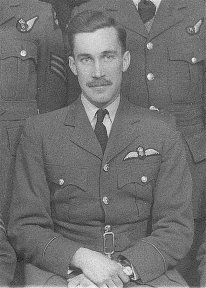
Donald Ernest Hillman F/L(P)
|
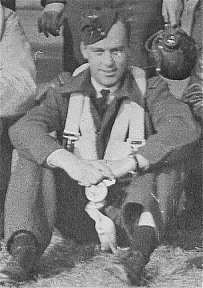
James Gordon Hillman F/O(N)
|
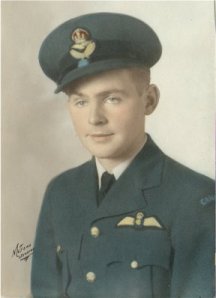
William Gavin Campbell F/L(P)
|
Tribute Sites
Donald
Ernest Hillman F/L(P) J17893
James
Gordon Hillman F/O(N) J21914
William
Gavin Campbell F/L(P) J21450/R119766
CORRESPONDENCE
Hello,
I am carrying out some research purely for personal interest
in RAF Moving Target Ranges as used for turret gunnery training during
WW2. These ranges consisted of an oval of narrow gauge railway track on
which a trolley with attached model aircraft ran, being fired at by gunners
under training.
There were a number of these ranges in the UK: at Millom,
Silloth, Theddlethorpe & Walney (Barrow) in England; Jurby ÍOM;
Dalcross, Dumfries, Tain, West Freugh, Wigtown in Scotland; and Hell's
Mouth in Wales. There is not much left of the ranges now but I am planning
to visit many of the sites to record what remains and see what I can discover
about the ranges.
I came across the Short Bursts magazine at www.airmuseum.ca/mag
whilst browsing on the web and wondered if there are any readers who may
have memories of training at these specific ranges ? Any information about
the ranges would be of interest, especially memories of how the ranges
operated and photographs, etc.
Many thanks,
John Gilby
16 Coombe Avenue
Wendover
Buckinghamshire
HP22 6BX
J.Gilby@lse.ac.uk
Letter, in part, from
Charley Yule
............I have received info from my daughter in
Calgary regarding the Nanton Museum planning their Annual 'Special Day'
on August 20th. 2005.
This has something to do with a refurbished engine
for their Lancaster and also the Dedication of a Wall Of Memory.
I believe they talked about this at the 'do' during the fall of 2004.
I am wondering if this might have anything to do with the 'Air Gunner's'
memorial benches proposed by Ted Hackett and the Edmonton Group of our
Association.....................
Ted Hackett reports on Nanton Memorial Benches
Good morning John. The two benches have been ordered
from a firm in Calgary, Westcon Precast. They are going to notify
me when they are ready for delivery. My youngest, Captain Bob, has
made arrangements with a unit in Calgary to pick up the benches and deliver
them to Nanton, they are going to do this as a Community Relations exercise.
I have been in touch with the Museum people in regards to this. The benches
are called Artisan Italian Benches and are curved in shape and weigh about
112 kilos. They are the type of bench you might find in a memorial park
or cemetery, the folks at the last luncheon thought they were a good choice.
I am supposed to get a site plan from Dave as soon as they have one drawn
up.
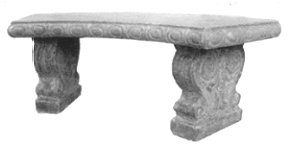
Hand poured curved concrete bench
Dave Southland
At the command of her Majesty she asks that you make
formal application for one of her Veterans Badges. Please go to www.207squadron.rafinfo.org.uk
and click on the green link saying Veterans Badge application form. Send
it in and in due course your badge will arrive as it did for me. By the
way, Veterans affairs Canada have also come up with a badge to commemorate
the “year of the veteran”.
Todd Yates ~ tayates@shaw.ca
Hello,
My name is Todd Yates. I am researching a 405 Squadron
aircrew who had just returned from OP's October 6/1942. They were flying
Halifax W7703 LQ-Q when it made a second attempt to land at West Malling
and crashed. The five Canadians onboard were killed, the remainder of the
crew managed to bail out before impact.
I am looking to talk or correspond with any ex 405 Squadron
members who might have known these brave Canadians. Is there any chance
you could place this query in the Short Bursts newsletter?
Here are the five Canadians who died:
Sgt.Michael Hudema
F/O Roy Erickson
Sgt. J.E Park
Sgt. N.Gislason
Sgt. J.F.P.Behn
Todd’s second letter
Hello John,
Thank-you for the quick response! One other question.
Do you know of anyone through short bursts that trained at 10 OTU Abingdon
in the spring of 1942. My Uncle trained and died during a night navex in
Wales May 9/1942. I'm looking for anyone who may have known him. I could
keep you busy for hours with questions! :-) I wish I had started asking
these questions many years ago. I was on the BBC news last year three times
looking for answers to my Uncle's death. Here's one of three links if you'd
like a quick read.
http://news.bbc.co.uk/1/hi/wales/mid/3569080.stm
Best wishes,
Todd Yates
Dear Mr. Moyles:
In the May edition of Short Bursts, I saw reference to
Cam Taylor of the 407 Squadron. My late father, Don McAskile, was with
the Royal Canadian Dental Corps during the war and was attached to the
407 Squadron for much of that time. Upon his 80th birthday in 1993, Mr.
Taylor and others awarded him honorary membership in the squadron.
I would like to contact both Mr. Tom Proctor and Mr. Ross
Hamilton to find out more about Mr. Taylor's health so that I can pass
on word to the rest of my family. He had been a close family friend prior
to my father's passing. I would also like to learn more about the history
of the squadron and if possible, my father's connection with it.
Many thanks for your assistance.
Best regards,
Andy McAskile
PricewaterhouseCooper LLP
Phone: 416-869-8725
Fax: 416-814-3200
andrew.mcaskile@ca.pwc.com
Editor’s Report
We thank those who put pen to paper, stamp to envelope,
and finger to keyboard, to make this Page possible. If you can help those
who have asked us for information, don’t hesitate to contact them direct.
Doreene and I are going to take a break during July and
August. This is Saskatchewan’s Centennial and there is a lot happening.
In the May Short Bursts Page there is a picture of an English Cemetery
that was founded in 1050. Our Province is spending millions celebrating
100 years!
It will be a time to sit in the sun and carve my walking
sticks. You can see one of the P/O Prune sticks at http://www.ryze.com/go/gopher
Keep well. Hopefully, we will be back in September.
John and Doreene Moyles.
|
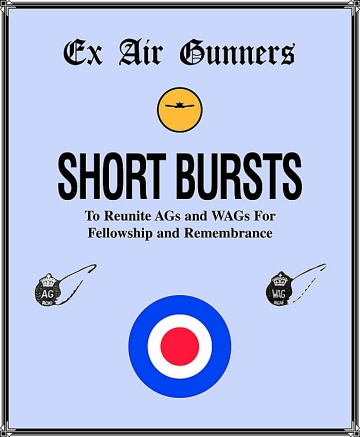


![]()
![]()
![]()
